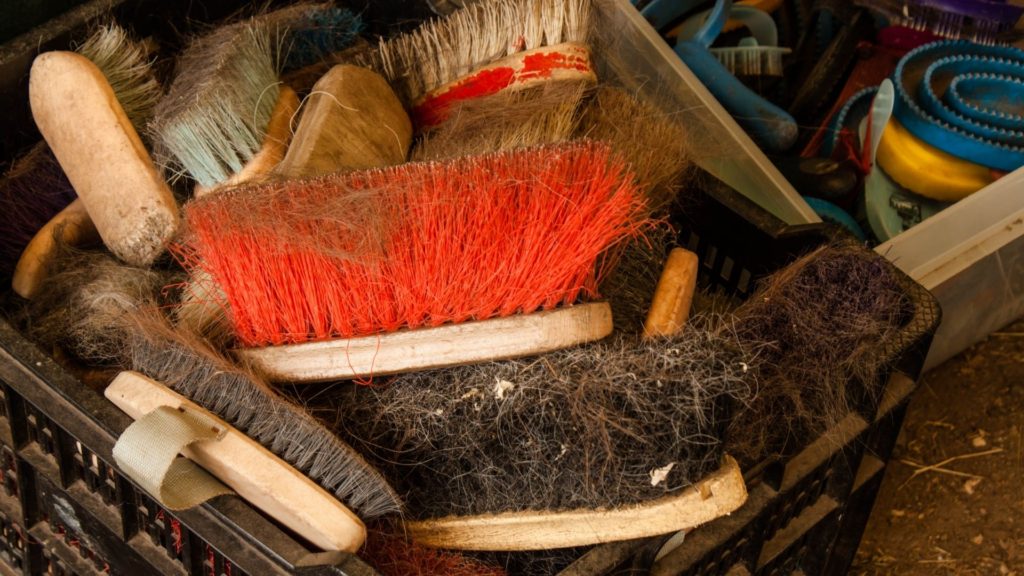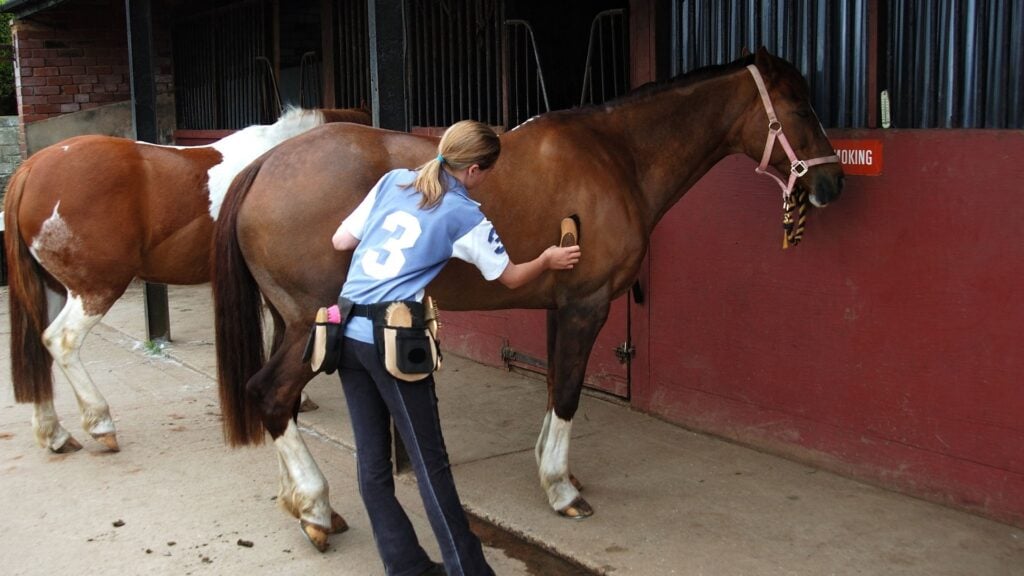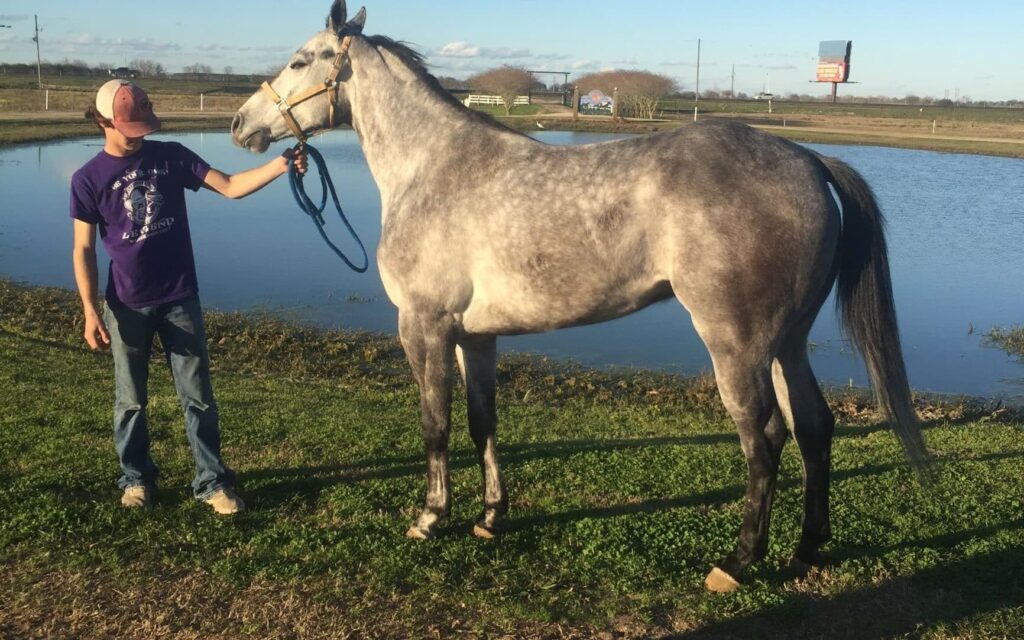Last updated: July 23, 2024
Have you ever wondered why grooming is essential for horses? Grooming is not just about keeping your horse looking good; it has several crucial benefits. In this article, we’ll explore why grooming is a vital part of horse care and provide some useful tips.
We’ll cover the health benefits of regular grooming, how it improves bonding between you and your horse, and the practical advantages of maintaining a well-groomed horse. Plus, you’ll find a step-by-step guide and essential grooming tools to make the process easier.

Health Benefits
Grooming your horse regularly offers crucial health benefits beyond mere aesthetics.
Prevents Skin Infections:
Regular grooming helps in removing dirt, sweat, and debris that can cause skin irritations and infections. This is especially important for preventing conditions like rain rot and dermatitis. According to the Merck Veterinary Manual, frequent cleaning and grooming are essential in managing and preventing skin issues.
Improves Circulation:
Brushing stimulates blood flow to the skin, promoting better circulation and a healthier coat. Studies show that grooming mimics the natural social behavior of horses, improving blood flow and contributing to a healthy, shiny coat. The increased circulation also helps distribute natural oils, keeping the coat smooth and glossy.
Early Detection of Health Issues:
During grooming, you can check for cuts, bruises, swelling, or other abnormalities. Early detection can prevent such issues from becoming serious problems. For example, a minor cut noticed during grooming can be treated before it becomes infected. The American Association of Equine Practitioners emphasizes the importance of regular grooming for early health issue detection.
Personal Anecdotes:
In my years of owning and grooming horses, I had a filly prone to skin irritations. Regular grooming sessions kept her coat clean and free from dirt and sweat buildup, preventing recurrent skin infections.
One of my older horses, Rusty, had a dull coat despite a healthy diet. I began using a curry comb regularly, and within weeks, his coat became shinier and healthier. The improved circulation from daily brushing made a noticeable difference and released natural oils, enhancing his coat’s shine.
I remember grooming my racehorse, Soldier, and noticing a slight ankle swelling. Early detection allowed immediate treatment, preventing a minor issue from becoming a severe injury that could have affected his racing performance.
By incorporating regular grooming into your routine, you ensure your horse stays healthy, happy, and beautiful. Equine health experts and my personal experience support these benefits, underscoring the importance of horse grooming.
Bonding
Grooming provides an excellent opportunity to bond with your horse. Spending time grooming your horse allows you to build trust and rapport. This bonding time is essential for developing a solid relationship between you and your horse.
Practical Benefits
There are several practical advantages to grooming your horse:
- Improved Appearance: A well-groomed horse looks better, which is especially important if you participate in shows or competitions.
- Better Performance: Regular grooming helps maintain the horse’s condition, ensuring they perform at their best. Clean and debris-free coats reduce the risk of saddle sores and other performance-related issues.
- Comfort and Well-being: Grooming helps keep your horse comfortable. Removing tangles, burrs, and debris from their coat and mane prevents discomfort and potential injury.
Essential Grooming Tools
To groom your horse properly, you’ll need the following tools:
- Curry comb
- Hard brush
- Soft brush
- Hoof pick
- Mane and tail comb
- Sponges
- Towels
For more information on horse grooming tools, see our detailed review of horse grooming kits.

Step-by-Step Grooming Process
1. How to Use a Curry Comb for Effective Grooming
Start with the curry comb to loosen dirt and debris from your horse’s coat. Use a circular motion to massage the skin and stimulate natural oils. This tool is especially useful for removing mud and shedding hair.
Example: I use a curry comb to remove dried sweat and dirt after training sessions when grooming my horses. This helps prevent skin infections and keeps their coats shiny.
2. Using a Hard Brush
After using the curry comb, use a hard brush to remove the loosened dirt and debris. Brush in short, firm strokes in the direction of the hair growth. Be gentle on sensitive areas like the belly and legs.
3. Soft Brush Usage
Use a soft brush to remove any remaining dust and smooth out the coat. This brush is gentle enough for sensitive areas and gives the coat a nice shine.
Example: My pleasure horse, Daisy, loves the soft brush. It helps to give her a shiny coat, and she enjoys the gentle strokes.

4. Hoof Pick Technique
Clean your horse’s hooves daily with a hoof pick to remove dirt, stones, and debris that can cause lameness or infections. Be sure to check for any signs of injury or disease. I have an article that details how to clean horses’ hoofs that you may find helpful.
Example: For horses that spend a lot of time in stalls, I always clean my horses’ hooves thoroughly to prevent thrush, a common hoof infection.
Hoof conditioners treat your horse’s hoofs and make them look good. A hoof conditioner I find works well and is reasonably priced is Farnam Horseshoer’s Secret Deep-Penetrating Hoof Conditioner, but there are plenty of other good brands available. I do strongly recommend you have some hoof conditioner on hand.
Pro tip: Use a lanolin-based hooves conditioner weekly to protect and condition your horse’s hooves.

Mane and Tail Care
Use a mane and tail comb to detangle and remove debris from the mane and tail. Be gentle to avoid pulling out hair. Regularly conditioning the mane and tail can keep them soft and manageable.
Example: Before a race, we spend extra time combing and conditioning my racehorses’ manes and tails to ensure they look their best on the track. You can find Mane n Tail Detangler on Amazon; it’s the go-to brand for many equestrians.
Pro tip: Never rip your comb through the middle of the tail in a hurry. It will cost you dearly later.

Bathing Your Horse
Bathing your horse is not always necessary but can be done occasionally to remove stubborn dirt or sweat. Use a mild horse shampoo and rinse thoroughly to avoid skin irritation.
Example: After a tough day’s work, I bathe my horse to remove all the dirt and sweat. I rinse well to prevent any soap residue from causing skin issues.
Below is a YouTube video offering grooming tips.
Additional Grooming Tips
Dealing with Skin Issues
Check your horse regularly for skin issues like rain rot or fungal infections. For more information on treating skin issues in horses, you can visit the MSD Veterinary Manual. This provides comprehensive details on identifying and managing various equine skin conditions, including dermatitis, thrush, rain rot, and more.
Applying Coat Conditioner
A coat conditioner can help keep your horse’s coat shiny and healthy. Use it after grooming sessions, especially during dry seasons.

Final Touches
After grooming, use sponges to clean your horse’s face and sensitive areas. Wipe down the coat with a damp towel to remove any remaining dust. Finish with a fly spray if necessary to keep bugs at bay.
Pro tip: Use soft or small brushes for the face and larger ones for the body.
One of the most important aspects of horse care is picking out your horse’s feet. This is because a lot can happen to their feet between groomings, and keeping your horse’s hooves healthy and clean is crucial.

Frequently Asked Questions about Horse Grooming (FAQs)
How often should I bathe my horse?
Depending on how often you take your horse out, you may want to bathe it once a week. The number of times a horse needs bathing depends mainly on the use of the horse. Avoid giving baths in winter when it is freezing. Horses can get sick if not dried properly. In summer, you could bathe your horse more frequently.
Should you brush your horse’s teeth?
Horses do not need teeth brushing. You could use products to remove tartar buildup, but brushing isn’t necessary. Ensure your horse’s teeth are checked and floated once or twice a year to keep its teeth healthy.
How often should you clean a horse’s sheath?
Generally, a horse’s sheath should be cleaned every six months to a year. However, if the horse is particularly dirty, has a lot of build-up of smegma in the sheath, or is experiencing a problem such as inflammation or infection, it may need to be cleaned more often.
What does it mean to rub a horse down?
The phrase “rubbing down a horse” is used when you use a curry comb to groom your horse. You hold it in your hand and move it in circles. It looks and feels like you are rubbing the horse with your hands.

Key Takeaways – How to Groom a Horse for Beginners
Regular grooming is crucial for your horse’s well-being. By following these horse grooming techniques, you can ensure your horse stays healthy, happy, and looking its best. For more detailed information on horse grooming, you can visit reputable sources like The Spruce Pets and Equisearch.
Thank you for reading about the importance of grooming your horse! We hope you found these tips helpful. We’d love to hear from you! Share your grooming tips, experiences, or questions in the comments below. Your insights could help fellow horse owners improve their grooming routines. Plus, don’t forget to check out our other articles on horse care for more valuable information. Let’s build a community of well-informed and passionate horse lovers!
As a long-time owner of various types of horses, I’ve found that consistent grooming keeps my horses healthy and strengthens our bond. For instance, my racehorse once had a minor cut that I noticed early during grooming, allowing me to treat it before it became a severe issue.
With regular grooming, your horse will be a pleasure to behold!

About the Author: Miles Henry
Lifelong Horseman | Racehorse Owner | Published Author
Miles Henry brings over 25 years of hands-on experience training and owning Thoroughbred racehorses. Raised with Quarter Horses and Appaloosas, he’s spent a lifetime learning from horses—on the track, in the barn, and in the field. Today, he runs a small but successful racing stable in Louisiana and shares real-world insights on HorseRacingSense.com, helping horse owners, fans, and bettors navigate the sport with confidence.
📚 Books: View Miles’s books on Amazon »
🎧 Podcast Guest: Animal Tales Ep. 32 |
YouTube Interview
📩 Newsletter: Sign up for racing tips and horse care advice »
🔗 Follow Miles:
Twitter |
Facebook |
YouTube


